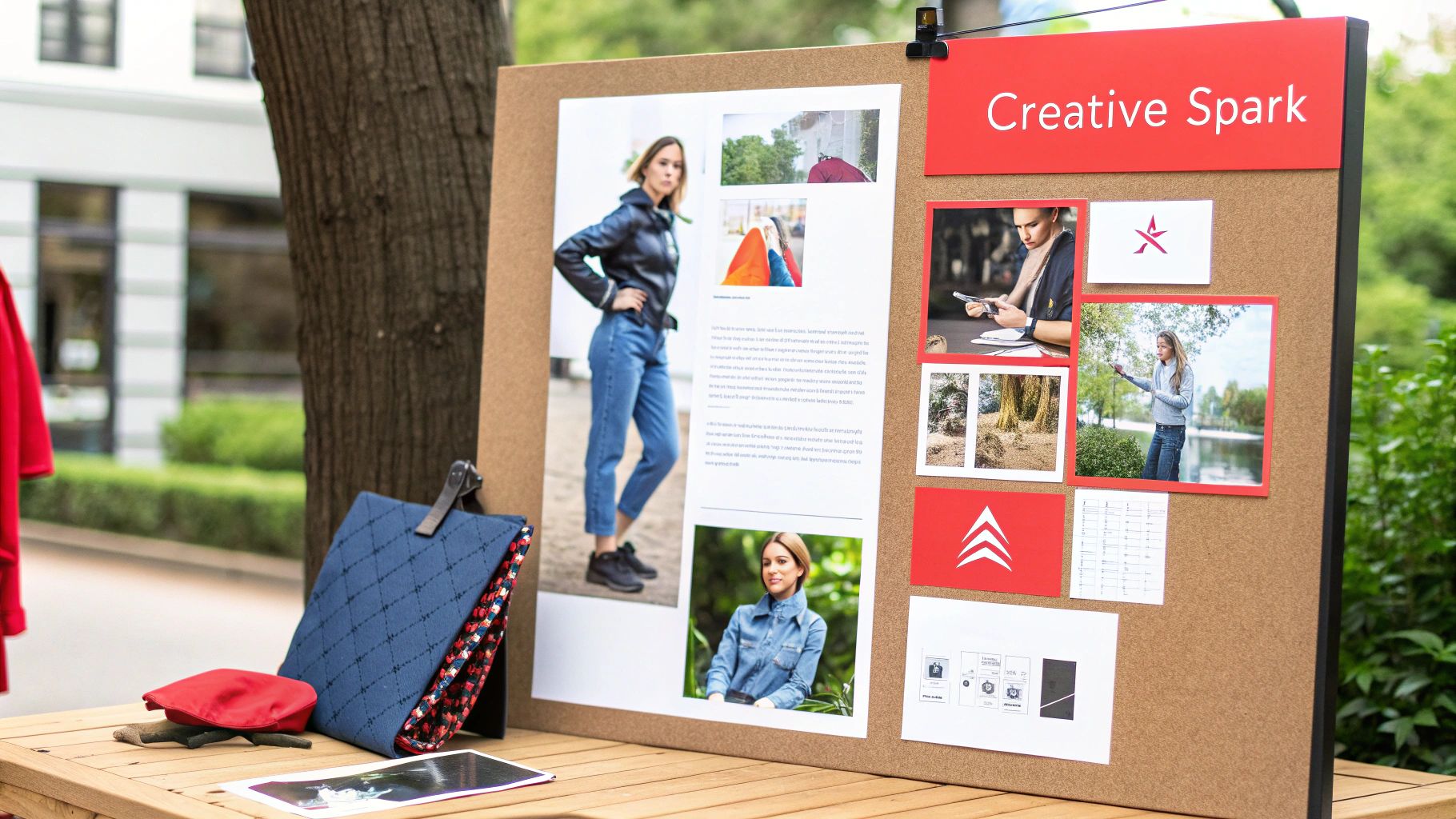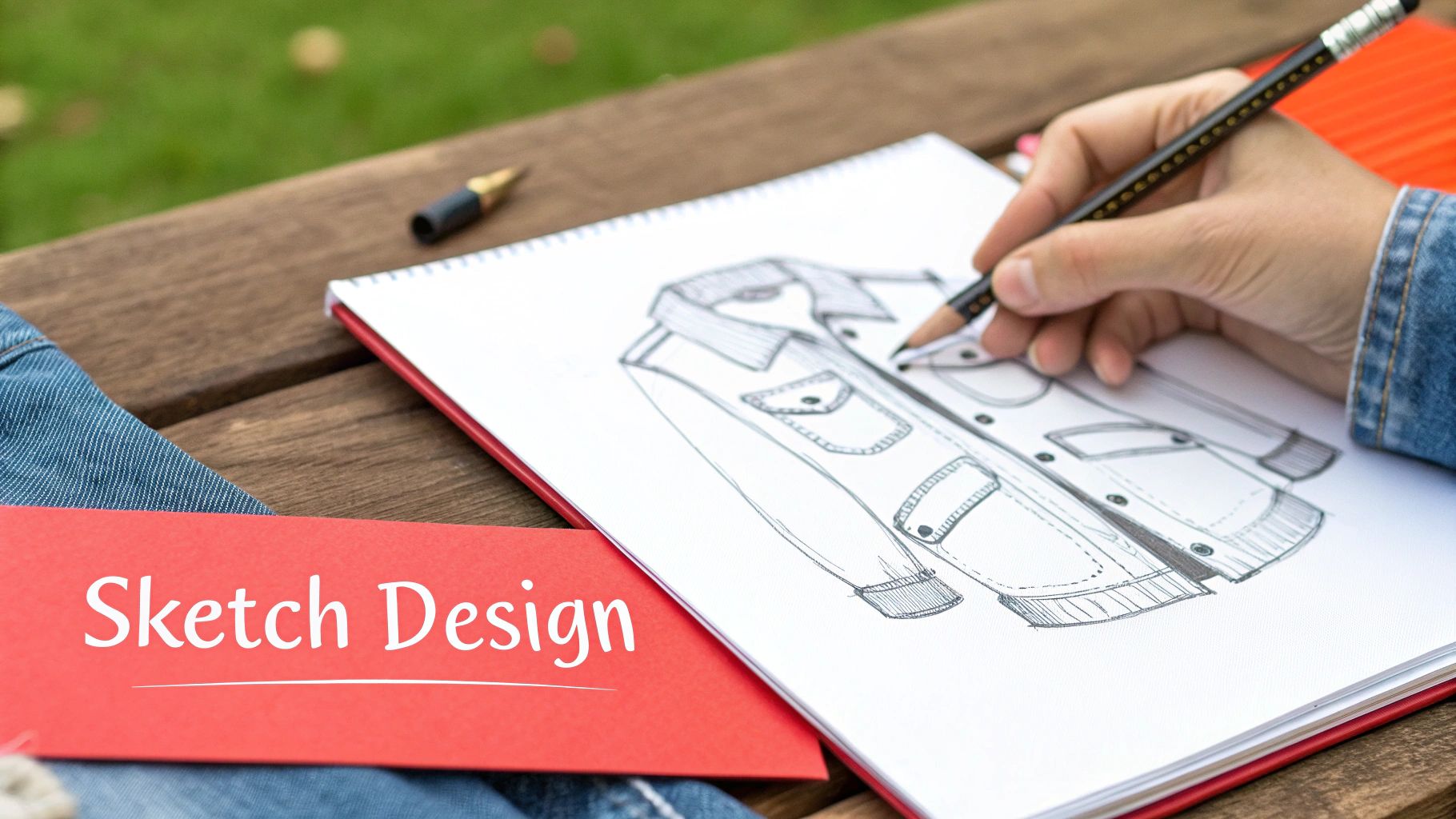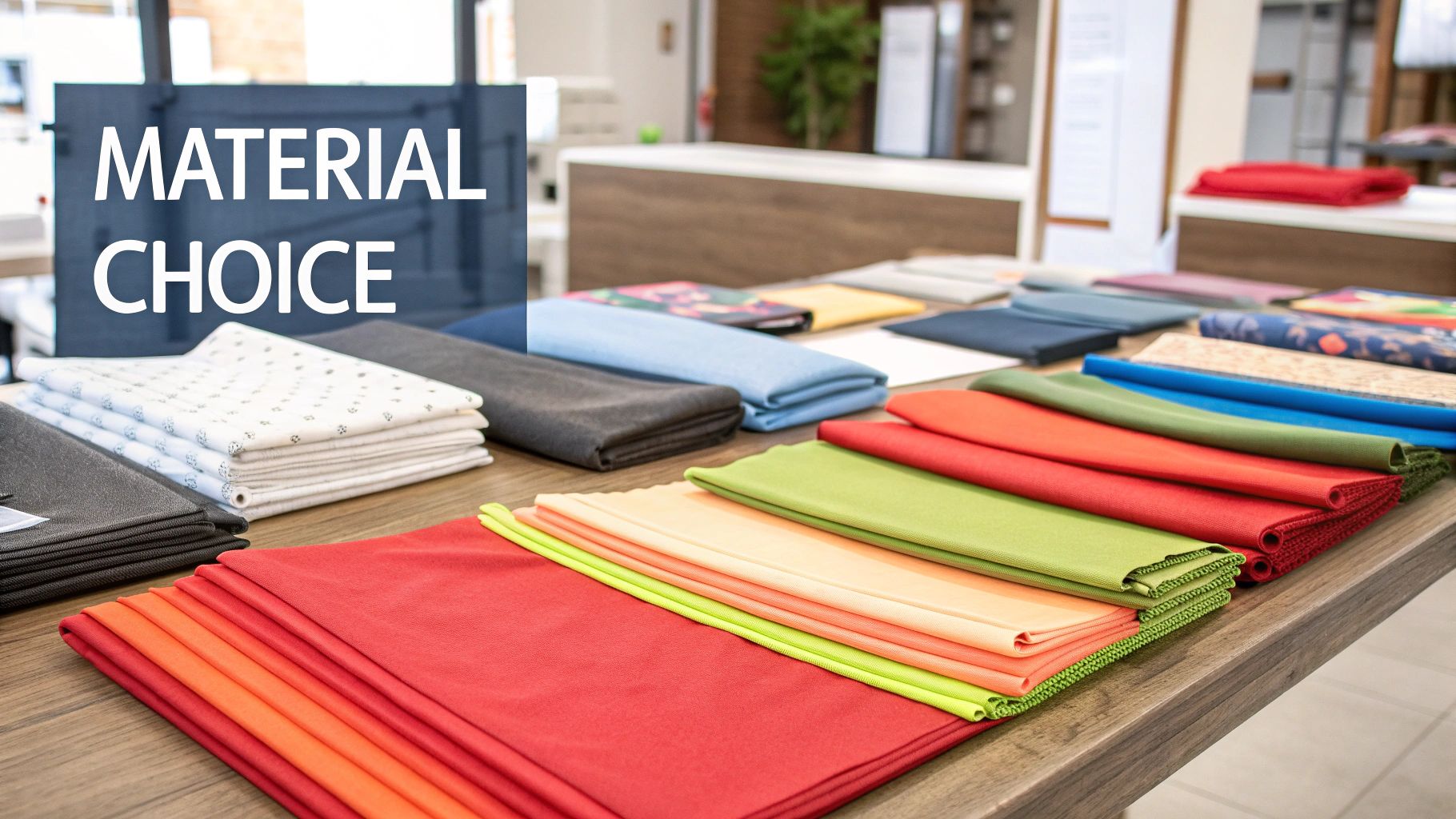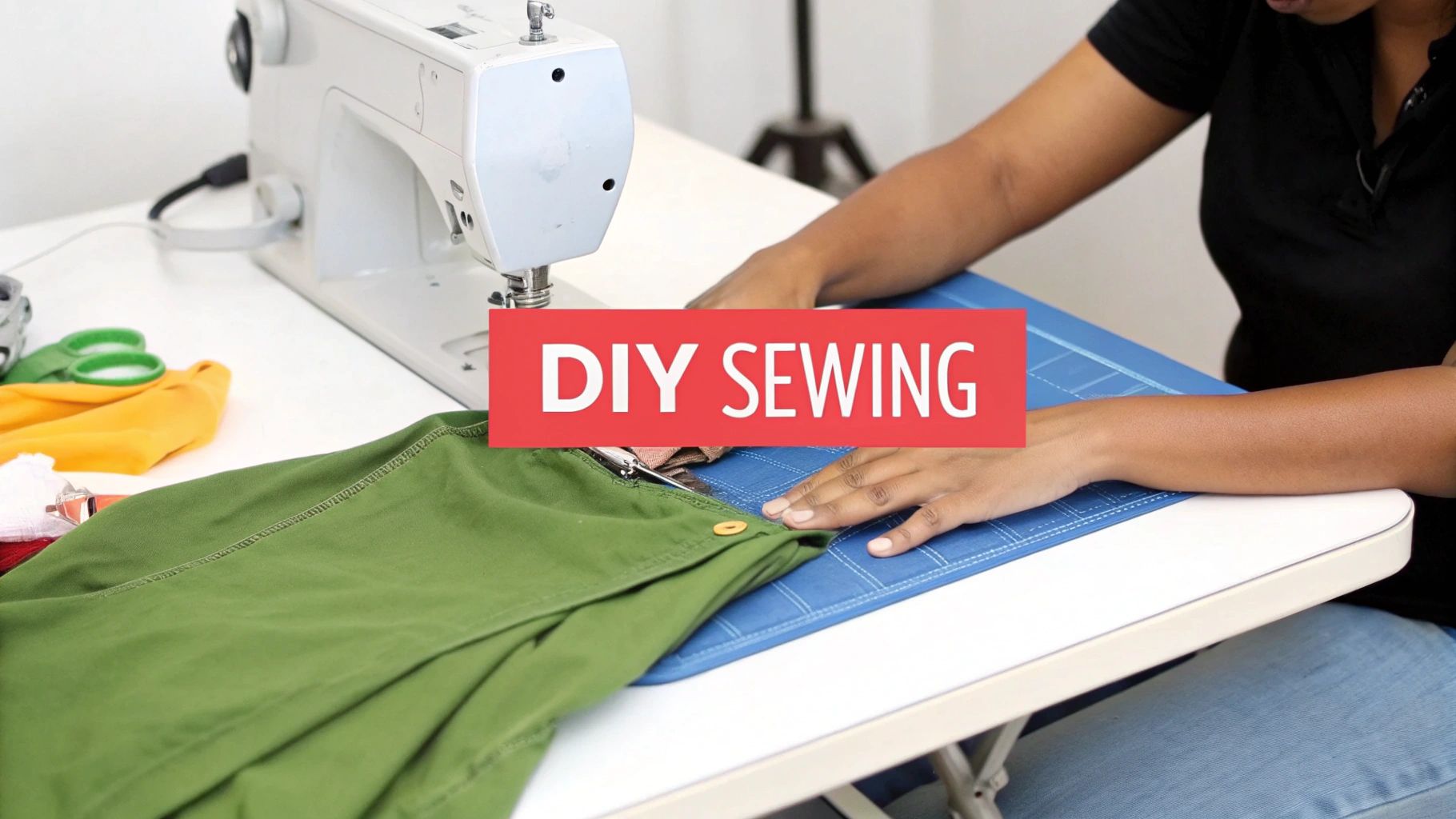Why Creating Your Own Clothes Changes Everything
Let's be honest, the feeling of wearing something you've made yourself is incredibly satisfying. Designing your own clothes offers a unique level of personal expression that goes beyond simply picking something out at a store. It's about bringing your individual style to life, creating garments that truly reflect who you are. Imagine a wardrobe filled with perfectly fitting pieces, each one a testament to your creativity. That's the power of designing your own clothes.
Express Your Individuality Through Design
Instead of settling for mass-produced items, you can design pieces tailored to your precise measurements and preferences. This allows you to create clothing that flatters your body shape and expresses your style in ways ready-to-wear clothing simply can't. Plus, you have complete control over the fabrics, colors, and embellishments, ensuring they align perfectly with your aesthetic vision.
Sustainable Style: Reducing Your Fashion Footprint
This control extends beyond aesthetics and into ethical choices. The environmental impact of fast fashion is significant. By designing your own clothes, you contribute to more sustainable practices. You can choose eco-friendly materials like organic cotton or recycled fabrics and minimize textile waste, fostering a more conscious approach to fashion. Designing your own clothes isn't just about personal style; it's also about responsible consumption.
The growing DIY fashion trend reflects this desire for control and sustainability, gaining traction worldwide, particularly among younger generations. These individuals design and create their apparel, finding inspiration on platforms like Instagram and Pinterest. This movement underscores a shift toward personalized and sustainable fashion choices. For more insights into this growing market, take a look at these statistics: Explore DIY market growth
The Confidence of Wearing Your Creations
The advantages of designing your own clothes extend beyond fit and sustainability. There's a real confidence boost that comes from wearing something you've poured your heart and soul into. Knowing you've brought your vision to life, from initial concept to finished garment, adds a sense of pride and satisfaction to every wear. This confidence radiates outwards, empowering you to express your true self.
From Beginner to Creator: A Journey of Self-Expression
Whether you're a complete beginner or have some sewing experience, designing your own clothes offers a fulfilling journey of self-discovery. It's not just about the end product; it's about the process of learning, experimenting, and finding your creative voice. Designing your own clothes allows you to take charge of your wardrobe and express yourself in a way that is truly unique. This creative outlet provides a sense of accomplishment and helps you stand out, showcasing your personality through every stitch.

The Designer's Toolkit: What You Actually Need to Start

Designing your own clothes doesn't have to be expensive. You can create impressive garments without emptying your wallet by focusing on the essentials. This guide will walk you through building a practical and budget-friendly toolkit, no matter your skill level.
Starting with the Basics: Essential Tools
Beginning designers can start with a minimal investment. A handful of key tools are all you need to launch your creative journey and design your own clothes.
-
Measuring Tools: Precise measurements are the cornerstone of successful design. A measuring tape, ruler, and French curve are essential for accurate body measurements and pattern drafting.
-
Cutting Tools: Sharp fabric shears are vital for clean, accurate cuts. These ensure precise pattern pieces and professional-looking seams. A rotary cutter and cutting mat are helpful additions, but not initially necessary.
-
Marking Tools: Tailor's chalk or a water-soluble marking pen helps transfer pattern markings onto fabric. This ensures proper alignment and construction throughout the design process.
-
Sewing Machine (Optional): While not strictly required for every design, a basic sewing machine can simplify the construction process, especially for new designers. Hand-sewing is a viable alternative.
Leveling Up Your Toolkit: Intermediate Essentials
As you gain experience and tackle more intricate projects, additional tools can elevate your designs and improve the quality of your finished garments. You might be interested in how to master diverse projects.
-
Dress Form: A dress form, adjusted to your measurements, is incredibly useful for visualizing how a garment will drape and fit. This allows for adjustments and refinements throughout the design process.
-
Pattern Making Software: Digital tools can significantly streamline pattern creation, offering both precision and flexibility. Many cost-effective options are available, making this a worthwhile investment.
-
Specialty Sewing Feet: Different sewing machine feet can greatly improve the quality of specific sewing tasks, such as zipper insertion, buttonhole creation, and working with tricky fabrics.
Advanced Tools: For the Dedicated Designer
For designers passionate about creating high-quality, unique garments, advanced tools can further enhance your work.
-
Serger: A serger creates professional-looking seam finishes and significantly speeds up construction, particularly for knit fabrics.
-
Embroidery Machine: Adding personalized embellishments with an embroidery machine elevates designs, creating unique, handcrafted touches. This adds a signature element to your garments.
-
Industrial Sewing Machine: These powerful machines provide speed, power, and precision. They are especially beneficial for complex constructions or when working with heavyweight materials.
The following table provides a breakdown of essential tools categorized by skill level and approximate cost range:
Essential Tools for Clothing Design by Skill Level
A breakdown of necessary tools and materials organized by beginner, intermediate, and advanced design skill levels
| Tool/Material | Beginner | Intermediate | Advanced | Approximate Cost Range |
|---|---|---|---|---|
| Measuring Tape | Essential | Essential | Essential | $5 – $20 |
| Ruler | Essential | Essential | Essential | $5 – $15 |
| French Curve | Essential | Essential | Essential | $5 – $15 |
| Fabric Shears | Essential | Essential | Essential | $10 – $50 |
| Tailor's Chalk/Marking Pen | Essential | Essential | Essential | $5 – $15 |
| Sewing Machine | Optional | Recommended | Recommended | $100 – $500+ |
| Dress Form | Recommended | Recommended | $100 – $300+ | |
| Pattern Making Software | Recommended | Recommended | $0 – $200+ | |
| Specialty Sewing Feet | Recommended | Recommended | $10 – $30 per foot | |
| Serger | Recommended | $200 – $1000+ | ||
| Embroidery Machine | Recommended | $200 – $2000+ | ||
| Industrial Sewing Machine | Recommended | $500 – $5000+ |
As your skills progress, consider investing in higher-quality tools that offer greater precision and durability.
Investing in the right tools at each stage of your design journey is key to creating high-quality garments that reflect your personal style. By focusing on essential equipment and gradually expanding your toolkit, you can maximize your creative potential while managing your budget effectively. Remember, designing your own clothes is a continuous process of learning and refinement. Embrace the process, and let your creativity thrive.
Transforming Ideas Into Wearable Designs

The journey from a fleeting thought to a finished garment involves a structured design process. Whether you're a seasoned designer or just starting out, understanding these steps can help you bring your clothing concepts to life. Let's explore how to refine your creative sparks into wearable designs you'll be proud to show off.
Developing Your Design Eye: Gathering Inspiration
The first step is cultivating your design eye. This means actively seeking inspiration from a variety of sources. Don't limit yourself to fashion magazines. Look to art, architecture, nature, and even everyday objects for unexpected ideas.
Imagine the intricate patterns on a butterfly's wing translated into a textile design. Or perhaps the sleek lines of a modern building could inspire the silhouette of a dress. Documenting these flashes of inspiration – whether through sketches, photos, or saved links – creates a valuable visual library to draw from later.
Translating Style Into Design Elements
Next, consider how to translate your personal style into concrete design elements. If your style is minimalist, you might focus on simple silhouettes, neutral colors, and high-quality fabrics.
A bolder aesthetic, on the other hand, might involve vibrant prints, intricate embellishments, or contrasting textures. Defining your core style elements provides a framework for your designs. For those wanting to deepen their knowledge, online fashion design courses offer a structured learning path.
Mastering Garment Structure: The Foundation of Good Design
A solid understanding of garment structure is essential for successful design. This includes learning about fabric drape, the impact of seams on fit, and how pattern pieces combine to create a three-dimensional form.
This knowledge empowers you to make informed decisions and avoid common design mistakes. A well-structured garment not only looks professional but also offers comfort and allows for ease of movement.
From Concept to Cutting Table: A Step-by-Step Guide
The global apparel market, projected to reach US$1.84 trillion by 2025, highlights the growing demand for unique, personalized style. Learn more about apparel market statistics. This trend underscores the value of designing your own clothes.
Accurate measurements are paramount for a flattering and comfortable fit. Learn to measure yourself correctly and accurately transfer those measurements to your pattern. Pattern development is where your design truly comes to life. Choose a pattern that aligns with your skill level and the desired silhouette.
Consider how the pattern pieces will interact with your chosen fabric. Experimenting with different fabrics helps you understand how they drape and behave. Finally, remember that setbacks are a natural part of the process. View mistakes as learning opportunities and keep practicing. With persistence, you’ll transform your ideas into wearable designs you’ll love.
Sewing Techniques That Transform Homemade to Handcrafted

The difference between a garment that looks "homemade" and one that appears professionally "handcrafted" often lies in the sewing techniques employed. A few key skills can significantly elevate your clothing designs, giving them a polished, high-quality appearance. This section explores essential sewing techniques that will transform your creations when you design your own clothes.
Precise Cutting: The Foundation of a Well-Made Garment
Accurate cutting is paramount to a successful sewing project. Think of it like constructing a building: a solid foundation is essential. Similarly, precisely cut fabric pieces are the foundation of a well-made garment. Using sharp shears and meticulously following pattern markings ensures clean, precise cuts. This allows your pattern pieces to align perfectly, creating a stable base for the rest of the construction.
Tension Control: Preventing Frustrating Thread Problems
Proper tension is crucial for smooth, even stitching. Incorrect tension can lead to a range of issues, from puckering to thread breakage. Finding the right balance for your thread tension is essential. Experimenting with different tension settings on scrap fabric can help you find what works best for your machine and thread type. This will prevent frustrating issues and give your seams a professional look.
Seam Finishes: Impeccable Inside and Out
Seam finishes not only prevent fraying but also contribute to the overall quality of your garment. They provide a clean, professional look on the inside, much like a beautifully wrapped present. Several techniques can be used, from a basic zigzag stitch to more advanced methods like French seams or using a serger. Choosing the right finish for your fabric and design adds durability and a polished touch.
Pressing Techniques: Achieving a Polished Look
Pressing, often overlooked, makes a noticeable difference in the final product. Just as ironing a shirt creates crisp lines and removes wrinkles, pressing your seams as you sew, and giving the garment a final press, significantly enhances its appearance. It creates a polished, professional finish that elevates the overall quality of your work.
Working with Challenging Fabrics: Avoiding Tears
Different fabrics require different approaches. Some are delicate and prone to stretching, while others are thick and challenging to sew. Understanding your chosen fabric's properties helps you choose the right needle and thread, as well as adjust your sewing machine's settings. This knowledge will prevent frustration and ensure a successful outcome.
Professional Details: Buttonholes and Zippers
Mastering seemingly small details, like buttonholes and zippers, can significantly impact a garment's overall quality. A precisely placed buttonhole or a smoothly functioning zipper adds both functionality and a professional touch. Practicing these techniques on scraps of fabric builds confidence and ensures a polished finish.
To help guide your fabric choices, take a look at this table:
Common Fabric Types and Their Properties
This table provides a comparison of popular fabrics used in clothing design, outlining their characteristics, recommended uses, and difficulty level for sewing. This information will help you select the appropriate fabric for your project and skill level.
| Fabric Type | Properties | Best For | Difficulty Level | Care Requirements |
|---|---|---|---|---|
| Cotton | Breathable, durable, easy to sew | Shirts, dresses, pants | Beginner | Machine washable |
| Linen | Breathable, strong, wrinkles easily | Summer clothing, home décor | Intermediate | Machine washable |
| Silk | Luxurious, delicate, drapes well | Formal wear, blouses | Advanced | Dry clean |
| Wool | Warm, durable, can be itchy | Sweaters, coats | Intermediate | Hand wash or dry clean |
| Denim | Durable, heavy, versatile | Jeans, jackets | Intermediate | Machine washable |
| Polyester | Wrinkle-resistant, durable, affordable | Activewear, linings | Beginner | Machine washable |
Understanding these fabric properties empowers you to choose materials that best suit your project and desired outcome. From everyday wear to special occasion pieces, the right fabric choice can make all the difference. By mastering these sewing techniques, you can transform your homemade creations into truly handcrafted garments.
Digital Tools That Revolutionize DIY Fashion Design
The world of DIY fashion design is experiencing a significant shift thanks to accessible digital tools. These technologies, previously only available to professionals, are making design more democratic, empowering individuals to create their own clothing. From initial idea to finished garment, digital tools offer exciting ways to express your personal style.
Streamlining The Design Process: Pattern-Making Software
Creating perfectly fitted patterns without the difficulties of traditional drafting is now a reality. Pattern-making software like Wild Ginger Software takes the frustration out of manual measurements and calculations, enabling precise digital pattern design. Many programs offer intuitive interfaces and diverse features, simplifying the creation of patterns tailored to your measurements. This digital approach not only improves accuracy but also unlocks opportunities for experimentation and intricate designs.
Visualizing Your Creations: Virtual Fitting Applications
One of the biggest hurdles in DIY fashion is envisioning how a design will look as a finished garment. Virtual fitting applications like Browzwear address this challenge by letting you create a digital avatar with your specific measurements and "try on" designs before cutting any fabric. This helps identify potential fit issues early on, saving time, material, and potential disappointment. You can experiment with various fabrics, colors, and styles virtually, ensuring the final product matches your vision.
Connecting and Learning: Online Communities and Resources
The DIY fashion community thrives online, offering support, inspiration, and practical advice. Online forums, social media groups, and dedicated platforms like BurdaStyle connect you with other designers. This allows you to share your projects, ask questions, and learn from shared experiences. This collaborative setting nurtures creativity and offers valuable resources for overcoming design challenges. Numerous online tutorials and resources also provide step-by-step instructions on various techniques, from basic sewing to advanced pattern making. Read also: Explore additional resources to further enhance your skills.
Showcasing Your Style: Social Media as a Design Tool
Platforms like Instagram and Pinterest are both inspiration hubs and powerful tools for showcasing your creations. They enable connections with other designers, provide feedback opportunities, and facilitate discovery of new trends and techniques. These platforms can also document your progress, build a portfolio, and even help sell your work. This digital space fosters a sense of community and presents valuable opportunities for growth and recognition. The connection between DIY culture and fashion is increasingly relevant. Approximately 55% of consumers now shop online for DIY products, highlighting a growing preference for digital channels. Find more detailed statistics here: Discover DIY market insights. Through these digital tools, you can transform your design ideas into reality and connect with a passionate community of creators.
Making It Uniquely Yours: Personalization Techniques
The most compelling reason to design your own clothes is the ability to express your individual style. This level of personalization simply isn't achievable with off-the-rack fashion. This section explores techniques to transform basic garments into personalized statements. Learn how to infuse meaning into your clothing and make your designs truly unique.
Embellishments: Adding Meaningful Details
Embellishments offer a powerful way to add distinctive touches to your clothes. Think beyond simple additions like beads or sequins. Consider incorporating elements with personal significance. For instance, repurposing a vintage button from a loved one's garment and sewing it onto a new piece adds sentimental value. Similarly, embroidery with Brother machines can be used to add initials, significant dates, or small designs representing a special memory or interest. These details elevate your garments from mere clothing to personal stories.
Blending Vintage and Modern: Creating Unique Combinations
Another exciting way to personalize clothing involves incorporating vintage materials into modern designs. A vintage scarf with a unique print could become a striking panel on a skirt or dress, adding a touch of history and texture. Similarly, vintage lace or buttons can embellish a modern garment, adding timeless elegance. This fusion of old and new creates a distinctive, one-of-a-kind look, making your designs truly stand out.
Creative Upcycling: Giving New Life to Existing Pieces
Upcycling provides a fantastic way to personalize clothes and embrace sustainable fashion. A worn-out t-shirt can find new life as a stylish tote bag. An old pair of jeans can be transformed into a fashionable skirt. This approach minimizes textile waste and gives garments a second chance. Upcycling presents a unique creative challenge, encouraging you to think outside the box and discover new possibilities within existing materials. Check out our guide on how to master diverse projects for inspiration.
Developing Your Signature Style: Making Your Mark
Through these personalization techniques, you can cultivate a signature style that makes your creations instantly recognizable. Perhaps you become known for intricate embroidery, your innovative use of vintage fabrics, or your upcycling skills. The more you experiment, the more you refine your personal aesthetic and develop a unique voice in the world of fashion. This individual expression is the ultimate reward of designing your own clothes. By focusing on achievable customization methods, you can maximize your creative impact and create garments that truly reflect your personality.
From Personal Project to Proud Showcase
Designing your own clothes is an incredibly rewarding experience. Once you've crafted something beautiful, you’ll want to share it with the world. This section offers practical advice on showcasing your unique creations, whether it's documenting your progress, building a portfolio, or even exploring the possibility of selling your designs.
Photography: Highlighting Your Garments' Best Features
Presenting your garments in the best possible light is crucial. Think like a fashion photographer! High-quality photos are key, but that doesn't always mean expensive equipment. Natural lighting, a clean background, and thoughtful styling can work wonders. Try draping your garment on a dress form to show off its shape or using a model to demonstrate its fit and movement. Close-up shots focusing on details like texture, stitching, and embellishments add a professional touch and highlight the unique elements of your design.
Building a Narrative Around Your Design Journey
Sharing the story behind your creations makes them even more compelling. What inspired your design? What challenges did you encounter? What decisions did you make about fabrics and techniques? This narrative adds context and depth to your work. Documenting your process, from initial sketches to the finished garment, not only showcases your skills but also inspires others. It’s a way to connect with your audience on a deeper level.
Connecting With Like-Minded Creators
The design world thrives on connection. Engaging with other designers offers valuable feedback, encouragement, and opportunities for growth. Online communities and platforms like Instagram and Pinterest provide excellent spaces to share your work and find inspiration. These connections can lead to collaborations and open up new possibilities. Constructive criticism from fellow creators can help you refine your skills and push your creativity further.
From Passion to Profession: Managing Expectations
Some DIY designers successfully transition to selling their creations. However, it’s essential to manage expectations and understand the realities of the fashion industry. Building a brand takes time, effort, and dedication. Start small, experiment, and grow gradually. For those who simply enjoy the process of creating their own clothes, the personal satisfaction of self-expression is often reward enough.
Sustainable Growth in the DIY Fashion World
Even if your goals are purely personal, thoughtful planning can support your future growth. Documenting your designs allows you to revisit past projects and identify recurring themes or techniques. Organizing your work by season, fabric, or inspiration can help you spot patterns in your style and plan future projects more efficiently. Consider ways to incorporate leftover fabrics into new designs for a more sustainable approach.
Designing your own clothes allows you to express your unique style. Showcasing your creations can be just as fulfilling as the design process itself. By presenting your work thoughtfully, you connect with others, inspire fellow creators, and celebrate the art of handmade fashion.
Ready to bring your unique clothing designs to life? ThisShirtExists.com empowers you to transform your ideas into reality using the power of AI. Create personalized gifts, one-of-a-kind apparel, or design something special just for you. Visit ThisShirtExists.com today and unleash your creativity!


